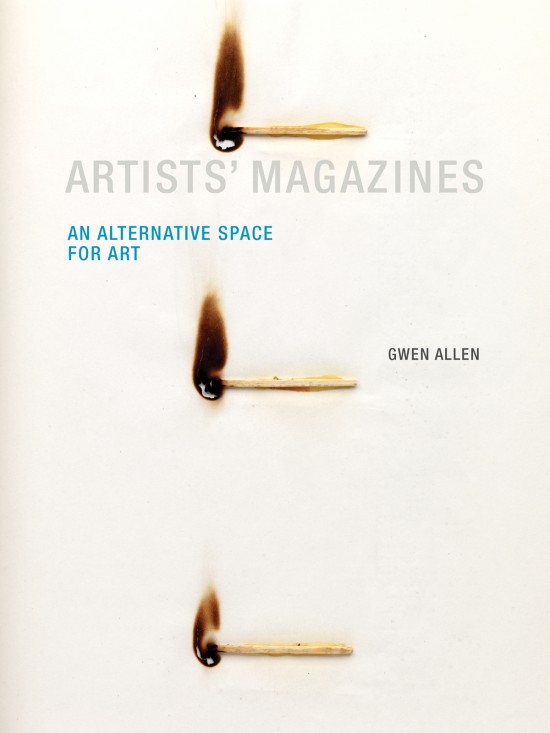Art of Digital London: TheKnowledge: Digital Strategy in Culture (2012)
Filed under book | Tags: · archive, community media, gaming, knowledge, learning, online video, p2p, peer production, publishing, social media, sound recording, video

It is the knowledge of the use of digital tools in a cultural context from its practitioners that we have called peer learning. Building on the experience of practitioners, addressing the needs of cultural organisations across all sizes and covering opportunities for artistic development to operational areas of production, the authors have put a series of articles and research using the collaborative writing tool, a Wiki.
Publisher OpenMute, London, March 2012
ISBN 978-1-906496-68-5, 978-1-906496-69-2
View online (HTML articles)
Comment (0)Gwen Allen: Artists’ Magazines: An Alternative Space for Art (2011)
Filed under book | Tags: · art, artists book, conceptual art, fluxus, magazine, mail art, photography, poetry, publishing

“Magazine publishing is an exercise in ephemerality and transience; each issue goes out in the world only to be rendered obsolete by the next. To publish a magazine is to enter into a heightened relationship with the present moment. During the 1960s and 1970s, magazines became an important new site of artistic practice, functioning as an alternative exhibition space for the dematerialized practices of conceptual art. Artists created works expressly for these mass-produced, hand-editioned pages, using the ephemerality and the materiality of the magazine to challenge the conventions of both artistic medium and gallery. In Artists’ Magazines, Gwen Allen looks at the most important of these magazines in their heyday (the 1960s to the 1980s) and compiles a comprehensive, illustrated directory of hundreds of others.
Among the magazines Allen examines are Aspen (1965–1971), a multimedia magazine in a box—issues included Super-8 films, flexi-disc records, critical writings, artists’ postage stamps, and collectible chapbooks; Avalanche (1970-1976), which expressed the countercultural character of the emerging SoHo art community through its interviews and artist-designed contributions; Art-Rite (1973-1978), an irreverent zine with a disposable, newsprint format; Real Life (1979-1994), published by Thomas Lawson and Susan Morgan as a forum for the Pictures generation; 0 to 9 (1967–1969), a mimeographed poetry magazine founded by Vito Acconci and Bernadette Meyer; FILE (1972–1989), founded by the Canadian collective General Idea, its cover design a sly parody of Life magazine; and Interfunktionen (1968–1975), founded to protest the conservative curatorial strategies of Documenta. These and the other magazines Allen examines expressed their differences from mainstream media in both form and content: they cast their homemade, DIY quality against the slickness of an Artforum, and they created work that defied the formalist orthodoxy of the day. (A work by John Baldessari from the late 1960s shows a photograph of Artforum, captioned “THIS IS NOT TO BE LOOKED AT.”) Artists’ Magazines, featuring abundant color illustrations of magazine covers and content, offers an essential guide to a little-explored medium.”
Publisher MIT Press, 2011
ISBN 0262015196, 9780262015196
300 pages
Reviews: Maarten van Gageldonk (Tijdschrift voor Tijdschriftstudies, 2012), Lucy Mulroney (West 86th, 2012), Alexander Provan (Bidoun, 2011), Dave Dyment (Magenta, 2012), Guy Crucianelli (PopMatters, 2011).
PDF (removed on 2018-8-20 upon request from publisher)
Comment (0)Gary Hall (ed.): Digitize Me, Visualize Me, Search Me: Open Science and its Discontents (2011-)
Filed under living book | Tags: · computing, data, data mining, data visualisation, digital humanities, knowledge, networks, open access, open data, open knowledge, open science, open source, publishing, science, search, web
![]()
“One of the aims of the Living Books About Life series is to provide a ‘bridge’ or point of connection, translation, even interrogation and contestation, between the humanities and the sciences. Accordingly, this introduction to Digitize Me, Visualize Me, Search Me takes as its starting point the so-called ‘computational turn’ to data-intensive scholarship in the humanities.
The phrase ‘the computational turn’ has been adopted to refer to the process whereby techniques and methodologies drawn from computer science and related fields – including science visualization, interactive information visualization, image processing, network analysis, statistical data analysis, and the management, manipulation and mining of data – are being increasingly used to produce new ways of approaching and understanding texts in the humanities – what is sometimes thought of as ‘the digital humanities’.” (from Introduction)
Publisher Open Humanities Press
Living Books About Life series
View online (wiki/PDF/HTML articles/videos)
PDF (PDF’d Introduction with hyperlinked articles)

